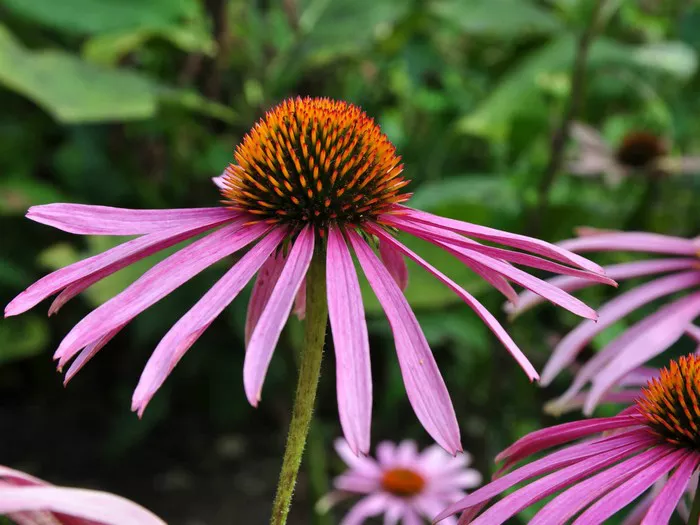Echinacea, commonly known as the purple coneflower, is a perennial plant native to North America. Revered for its striking appearance and medicinal properties, echinacea has been used for centuries by various indigenous cultures for its health benefits. While its therapeutic properties are well-known, echinacea flowers offer a multitude of other uses beyond their medicinal applications. From culinary delights to ornamental beauty, let’s explore the diverse ways in which echinacea flowers can be utilized.
1. Medicinal Purposes:
Echinacea flowers are perhaps most renowned for their medicinal properties. Rich in antioxidants, such as flavonoids and phenolic compounds, echinacea is believed to boost the immune system and alleviate symptoms of the common cold and other respiratory infections. The roots, leaves, and flowers of the plant are commonly used in herbal remedies, either in the form of teas, tinctures, or supplements.
2. Herbal Tea:
One of the simplest ways to enjoy the benefits of echinacea flowers is by brewing them into a soothing herbal tea. The flowers can be dried and steeped in hot water to create a fragrant infusion that not only provides a refreshing beverage but also helps support immune health. For added flavor and complexity, echinacea flowers can be combined with other herbs such as peppermint or lemon balm.
3. Culinary Applications:
Beyond their medicinal properties, echinacea flowers can also lend a unique flavor and aesthetic appeal to various culinary creations. The petals, with their slightly sweet and mildly floral taste, can be used to garnish salads, desserts, and cocktails. Echinacea flowers can also be candied or infused into syrups to add a subtle floral note to baked goods and beverages.
4. Natural Dye:
The vibrant hues of echinacea flowers make them a popular choice for natural dyeing projects. The petals can be boiled to extract their pigment, which can then be used to dye fabrics, yarns, and even Easter eggs. Depending on the method and mordant used, echinacea dye can yield shades ranging from soft pastels to rich purples.
5. Ornamental Beauty:
In addition to their practical uses, echinacea flowers are prized for their ornamental beauty. With their striking purple petals and prominent cone-shaped centers, they add visual interest to gardens and landscapes. Echinacea varieties come in an array of colors and sizes, making them versatile choices for floral arrangements and bouquets.
6. Wildlife Habitat:
Echinacea flowers play a vital role in supporting biodiversity by providing food and habitat for various wildlife species. Pollinators such as bees, butterflies, and hummingbirds are attracted to the nectar-rich blooms, helping to pollinate other plants in the surrounding area. Additionally, birds may feed on the seeds produced by mature echinacea flowers, further contributing to ecosystem health.
7. Herbal Skincare:
The beneficial properties of echinacea extend to skincare as well. Extracts derived from echinacea flowers are commonly used in natural skincare products for their anti-inflammatory and antimicrobial properties. Echinacea-infused creams, lotions, and serums may help soothe irritated skin, reduce redness, and promote overall skin health.
8. Companion Planting:
Echinacea flowers are not only aesthetically pleasing but also serve a practical purpose in the garden. As part of companion planting schemes, they can help repel pests and attract beneficial insects, thus promoting overall garden health. Planted alongside vegetables and other flowering plants, echinacea can contribute to a more balanced and resilient garden ecosystem.
9. Symbolic Significance:
Throughout history, echinacea flowers have held symbolic significance in various cultures. Traditionally, they have been associated with strength, resilience, and healing. In Native American folklore, echinacea was revered as a sacred plant with powerful medicinal properties. Today, echinacea continues to be celebrated as a symbol of vitality and wellness.
10. Herbal Crafts:
For those inclined toward DIY projects, echinacea flowers can inspire a variety of creative endeavors. Dried petals can be used to make potpourri, sachets, or herbal wreaths. Echinacea flowers can also be pressed and preserved to create botanical artwork or incorporated into handmade paper for a unique touch.
In conclusion, echinacea flowers are not only valued for their medicinal properties but also offer a wealth of other uses ranging from culinary delights to ornamental beauty. Whether enjoyed in a cup of herbal tea, adorning a delicious dish, or gracing a garden with their vibrant blooms, echinacea flowers continue to captivate and inspire. Embracing the versatility of echinacea opens up a world of possibilities for incorporating this beloved plant into various aspects of daily life.


